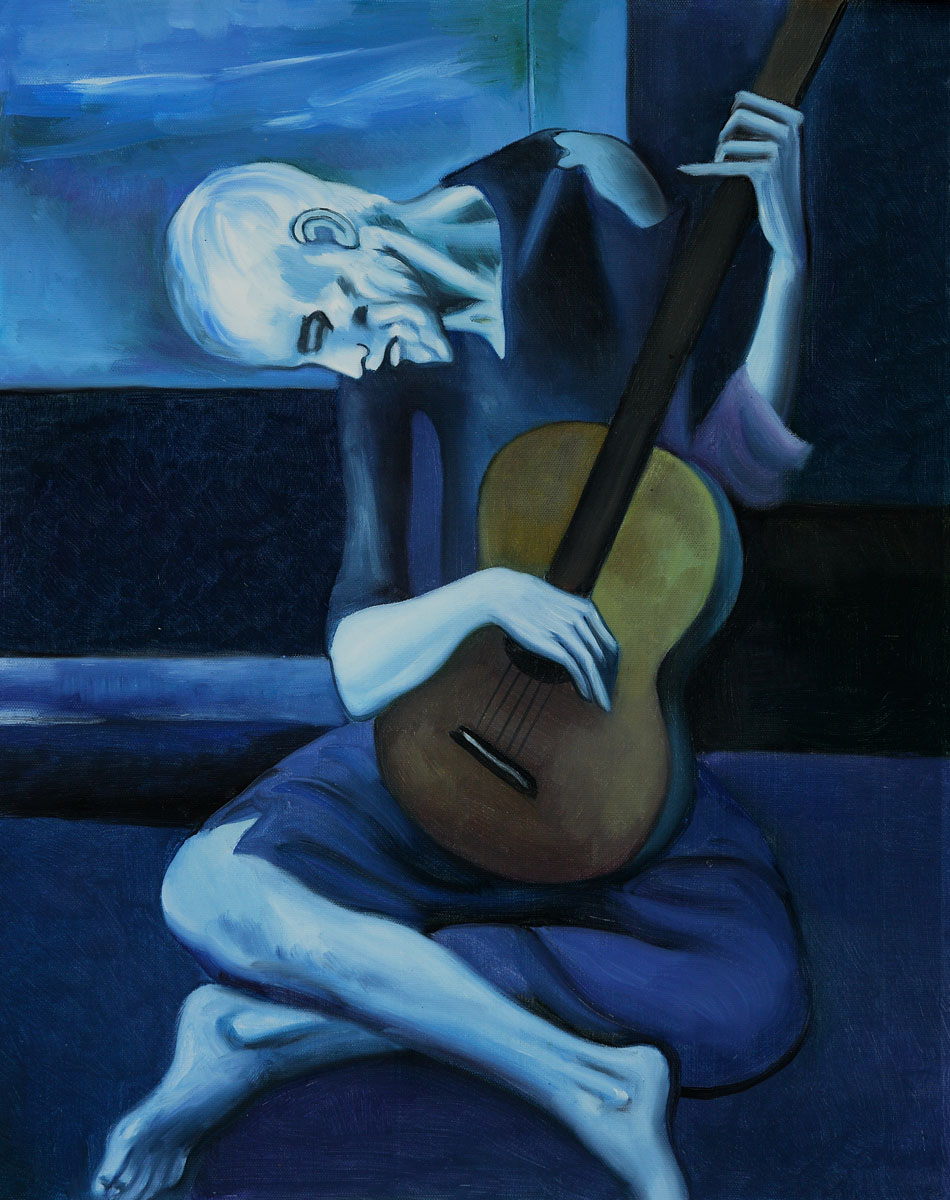Introduction:
“The Old Guitarist,” a masterpiece by the legendary Pablo Picasso, stands as an iconic representation of the artist’s Blue Period. Painted in 1903 during a time of personal turmoil and societal upheaval, this haunting depiction of an elderly musician resonates with profound emotional depth and symbolism. In this extensive review, we will embark on a journey through the layers of “The Old Guitarist,” exploring its historical context, artistic elements, emotional resonance, and enduring impact on the world of art.
Section 1: The Blue Period
“The Old Guitarist” is a quintessential work from Picasso’s Blue Period, a significant phase in the artist’s career characterized by somber hues, introspective themes, and a deep exploration of human suffering. The Blue Period emerged in the aftermath of Picasso’s friend Carlos Casagemas’s suicide and reflected the artist’s own emotional turmoil and empathy for the downtrodden.
Section 2: Historical Context
The early 20th century was marked by societal and cultural shifts, with Europe undergoing profound changes. Picasso, living in Paris, witnessed the effects of poverty, despair, and social inequality. These experiences, coupled with personal challenges, fueled the artist’s inclination towards themes of poverty, loneliness, and the human condition – all of which find poignant expression in “The Old Guitarist.”
Section 3: The Old Guitarist as a Symbol
At the center of the painting is an elderly, emaciated guitarist hunched over his instrument. The skeletal figure, shrouded in a flowing blue robe, becomes a symbol of human suffering and endurance. The guitar, a recurring motif in Picasso’s work, takes on dual significance – a source of solace for the musician and an emblem of the transformative power of art amid hardship.
Section 4: Use of Color
The Blue Period is characterized by a subdued palette dominated by shades of blue and blue-green. In “The Old Guitarist,” Picasso employs a monochromatic spectrum, intensifying the melancholy and emphasizing the emotional weight of the subject matter. The pervasive blue tones create an otherworldly atmosphere, evoking a sense of desolation and spiritual introspection.
Section 5: The Symbolism of Blue
Blue, in Picasso’s Blue Period, serves as a metaphor for the emotional and psychological states explored in his work. It becomes a visual language conveying the depths of despair, the fragility of life, and the search for transcendence. The pervasive use of blue in “The Old Guitarist” heightens the sense of vulnerability and emphasizes the universality of human suffering.
Section 6: Composition and Form
Picasso’s composition in “The Old Guitarist” is both evocative and deliberate. The musician, elongated and gaunt, dominates the canvas. His bowed head and contorted hands convey a sense of resignation and introspection. The vertical orientation of the painting enhances the figure’s isolation, emphasizing the solitude and emotional weight of the subject.
Section 7: Influences and Artistic Evolution
“The Old Guitarist” not only reflects Picasso’s emotional state during the Blue Period but also showcases his evolving artistic style. Influenced by El Greco and the Spanish tradition, Picasso’s elongation of forms and emphasis on expressive distortion contribute to the painting’s emotional impact. The transition from the formalism of his earlier work to the expressive power of the Blue Period marks a pivotal phase in Picasso’s artistic journey.
Section 8: Emotional Resonance
The emotional resonance of “The Old Guitarist” lies in its ability to evoke empathy and contemplation. The figure’s suffering becomes a universal symbol of the human experience, transcending individual circumstances. Viewers are invited to engage with the painting on a visceral level, prompting reflection on themes of loss, resilience, and the redemptive power of art.
Section 9: Picasso’s Social Commentary
Beyond personal expression, “The Old Guitarist” serves as a social commentary on the plight of the marginalized and downtrodden. Picasso, deeply affected by the struggles of the impoverished, uses his art as a vehicle to amplify the voices of the disenfranchised. The painting becomes a testament to the artist’s social consciousness and his commitment to portraying the human condition in all its complexities.
Section 10: Legacy and Impact
“The Old Guitarist” remains a cornerstone of Picasso’s oeuvre and a landmark in the evolution of modern art. Its emotional depth and social relevance have ensured its lasting impact, influencing subsequent generations of artists who grapple with themes of human suffering, resilience, and the transformative power of artistic expression.
Section 11: Conservation and Display
Currently housed in the Art Institute of Chicago, “The Old Guitarist” has undergone careful conservation efforts to preserve its integrity. Its prominent place in the museum’s collection allows visitors to engage with Picasso’s masterpiece firsthand, immersing themselves in the emotional and visual richness of the painting.
Section 12: Educational Significance
“The Old Guitarist” continues to serve as an educational tool, offering art enthusiasts, students, and scholars an opportunity to delve into the complexities of Picasso’s Blue Period. Its inclusion in art history curricula ensures its enduring significance as a subject of study and contemplation.
Section 13: Conclusion – A Poetic Meditation
In conclusion, “The Old Guitarist” by Pablo Picasso transcends the boundaries of time and artistic movements to stand as a poetic meditation on the human condition. Through its expressive power, masterful use of color, and poignant symbolism, the painting invites viewers to traverse the emotional landscape of suffering, resilience, and the enduring solace found in the transformative embrace of art. Picasso’s evocative portrayal of the old guitarist becomes a timeless testament to the capacity of art to illuminate the darkest corners of the human soul and, in doing so, offer solace, reflection, and a shared understanding of the universal journey we all navigate.
